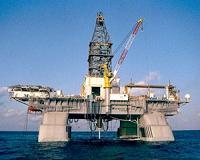 |
New Orleans, Louisiana (AFP) July 25, 2010 Engineers moved ahead Sunday with preparations for a well "kill" operation that officials hope will permanently plug the oil leak causing the worst US environmental disaster. A major vessel charged with drilling a relief well to finally stop the BP oil spill arrived back at the Gulf of Mexico well site Saturday after briefly evacuating due to a tropical storm. US Coast Guard Admiral Thad Allen said the first chance to seal the well for good could come in the next few days, as response crews quickly scaled operations back up after the storm fizzled. "That is a very rough estimate, three to five days from now," Allen said. The returning drill rig, Development Driller 3 (DD3), was among some 10 ships that evacuated the area ahead of Tropical Storm Bonnie. It was to begin reattaching to the well site immediately, according to the US official overseeing the spill response. A cap over the wellhead has shut in leaking oil since July 15. But officials and residents are desperate to permanently resolve the disaster, more than three months after the April 20 explosion aboard the BP-leased Deepwater Horizon oil platform which killed 11 workers and sank the rig. The International Energy Agency estimates that between 2.3 million and 4.5 million barrels of crude have gushed into the sea as a result of the leak. A spokesman for the British energy giant, Bryan Ferguson, said it would take around 21 hours to reconnect the DD3 to drilling operations some 5,000 feet (1,500 meters) below the sea surface. The rig is drilling the first of two relief wells that will be used to definitively plug the devastating spill. BP and US officials currently plan two operations to kill the well. The first, a "static kill," involves pumping heavy drilling fluid known as mud through the blowout preventer valve system that sits on top of the well, and then injecting cement to seal it. The process is similar to a "top kill" attempt that failed in May, but officials say the cap now in place over the leak will make the operation easier and more likely to succeed. However, BP and US responders have said the ultimate solution to the leak will be via the relief wells, which will intersect the original well. Using the same process as the static kill, drilling fluid, which is denser than oil, will be pumped via the relief well until the flow of crude is overcome, allowing the damaged well to be sealed with cement. Before either can begin, the last section of the relief well must be secured with a 3,000-foot piece of steel pipe called a "casing run", which will be cemented in place. "You're probably into three to five days from now when they might be able to be in a position to have the casing pipe in place and we could probably start the static kill at that point," Allen said. The spill has now washed up oil along the shorelines of all five US states on the Gulf Coast. But amid Saturday's high anxiety over the storm and the evacuation of vessels that aimed to keep workers and equipment safe, some experts said the high waves kicked up by Bonnie might actually help dissolve some of the oil faster. "We expect that Bonnie should help dissipate and weather the oil that's at the surface, it will spread the surface slick out and thereby lower concentrations," said Jane Lubchenco, who heads the National Oceanic and Atmospheric Administration (NOAA). The storm would "also cause more natural dispersion, again lowering the concentration and making it more available to natural bacteria that are in the water," she said. Other experts argue that surface currents bolstered by high winds would likely shift the near-surface oil closer to the Gulf Coast and spread it over a larger area, and that a severe storm surge from the likes of a hurricane could send fouled water far up into the bayous, contaminating fragile spawning grounds for fish and shrimp. In Larose, a Louisiana town near the Mississippi River delta, a shrimper named Barry who now does spill clean-up work for BP said Gulf Coast residents dodged a bullet when Bonnie fizzled. "If we can get lucky and just have Bonnies, we would fare a lot better," he told AFP. "A hurricane anything more than minimal size, even a big tropical storm, is going to be devastating to this entire area."
Share This Article With Planet Earth
Related Links Powering The World in the 21st Century at Energy-Daily.com
 Alarm on Gulf oil rig muted before blast: witness
Alarm on Gulf oil rig muted before blast: witnessNew Orleans (AFP) July 23, 2010 An alarm that should have alerted workers on the Deepwater Horizon oil rig to a deadly build-up of gas that sank the platform, sparking a huge oil spill, had been muted months before, a former rig worker said Friday. The alarm system which uses lights and alarms to warn of fire or high-levels of toxic or explosive gases, had been "inhibited," Mike Williams, the chief electronics technician o ... read more |
|
| The content herein, unless otherwise known to be public domain, are Copyright 1995-2010 - SpaceDaily. AFP and UPI Wire Stories are copyright Agence France-Presse and United Press International. ESA Portal Reports are copyright European Space Agency. All NASA sourced material is public domain. Additional copyrights may apply in whole or part to other bona fide parties. Advertising does not imply endorsement,agreement or approval of any opinions, statements or information provided by SpaceDaily on any Web page published or hosted by SpaceDaily. Privacy Statement |